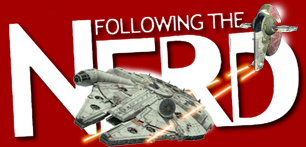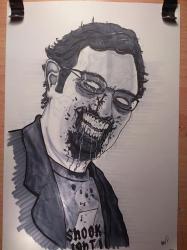It’s not every day you get a very noted science fiction author to write a cartoon episode that incorporates their most famous creation.
Arthur C. Clarke, for example, never introduced Yogi Bear to a large black monolith, or had Top Cat make a rendezvous with Rama. Isaac Azimov never brought the three laws of robotics to the Jetson’s housemaid Rosie. And HG Wells certainly never had any involvement in the development of Marvin the Martian.
Yet Larry Niven, famed author of the Known Space series, adapted his short story The Soft Weapon for Star Trek: The Animated Series, to create The Slaver Weapon. For those not in the know, The Animated Series was the first attempt at reviving Star Trek, this time in budget-friendly animated format. Inevitably, there were compromises. Action and violence were toned down for the Saturday morning slot and to keep the cost of animation down, production company Filmation produced a finished product that had plenty of stock footage and character animation that could be described as adequate at best.
But the writing was good and the original cast, with the notable exception of Walter Koenig, returned to voice their characters despite a few disputes. As if retaining previous Star Trek writers like DC Fontana and David Gerrold wasn’t enough, the production team decided to try and land a few bigger names.
Producer and staff writer DC Fontana approached Larry Niven in 1973 with the invitation to write for the Star Trek universe. Niven had won a Hugo award for his 1971 novel Ringworld and was considered a rising star of science fiction literature. He was interested in writing Star Trek and submitted two story ideas. The first, involving bizarre non-humanoid aliens with body temperatures close to absolute zero using “quantum black holes” to immobilise and rob passing ships, was considered unworkable by Fontana, considering the show’s Saturday morning slot and kiddie demographic. The second, she thought “too bloody”.
Niven visited Gene Roddenberry at home, when the Trek supremo recommended that Niven adapt one of his existing short stories, suggesting short story The Soft Weapon. Niven then set to and adapted the story, becoming The Slaver Weapon.
Niven lifted several aspects of his Known Space series into The Slaver Weapon. The Kzinti, a race of warlike felines, were brought over wholesale with the backstory that they once fought an interstellar war against Humanity. The extinct Slaver race and their stasis box MacGuffin were likewise incorporated. Spock, Sulu and Uhura replaced the three protagonists of the story, and the rest was history.
So, the story sees three of the Enterprise’s finest ferrying a Slaver stasis box to a nearby starbase. Only a few of these boxes had been discovered by archaeologists over the years, their contents perfectly preserved inside and impervious to any form of sensor. Upon opening, one of them contained advanced artificial gravity technology, while another had a live grenade with the pin pulled. The mission for Spock, Uhura and Sulu is to get the box to a base where it can be opened in safety. The box, however, begins to indicate that another box is in relatively close proximity, as they can apparently detect each other.
The crew and their shuttle duly land on a frozen planet, only to be captured by the pink spacesuited Kzinti, a race of somewhat mangy giant housecats. They’ve been using an empty stasis box to lure unsuspecting rubes in order to relieve them of their own stasis boxes. Opening the box, they find a personal weapon with several ‘settings’ that each causes it to shapeshift into another form. Testing the thing, the Kzinti find that one of the settings accidentally disables the forcefield holding the Enterprise team. Spock puts the boot into the Kzinti captain, nick the weapon and knife it away, but Uhura is captured (of course, this being the 70s, the damsel in distress trope still runs strong).
As Sulu plays with the device, he determines that it belonged to a spy as the only offensive setting is a relatively weak laser while the others seem geared to defeating security measures, incapacitating guards and gathering intelligence. But while messing about with it, Sulu discovers a secret setting: a beam that converts matter directly into energy and creates an explosion that makes the H-bomb look like a firecracker. Of course the explosion leads the Kzinti right to them, the pair are captured again and the moggies began faffing about with the weapon. They discover a computer setting, a form of artificial intelligence that does not know how long it has been in stasis, only that the people who possess it are demanding to know all its’ secrets and they don’t know any of its’ access codes. The weapon changes into a new form, leading Spock to guess that it has engaged its self-destruct mode. There is an earth-shattering kaboom, the bad guys are all wiped out, and the Enterprise crew head off on their merry little way.
So, is it as good as it seemed at first? Well… no. Sadly, this episode does fall down on several fronts. The crew wear the truly ridiculous ‘life support belts’ to protect them from the elements, instead of the more logical space suits. This stupid bit of artistic licence means that, with no air supply or visible means of communication, a belt that generates a Ready Brek glow around the wearer can stop them from asphyxiating, drowning, freezing or baking. Next, there’s the fact that all the Kzinti equipment is just re-coloured Starfleet kit. Then the Kzinti ship, space suits and equipment are all pink. Yep, pink. Unlike the primary coloured hues of The Original Series, this wasn’t intentional. Director Hal Sutherland was colourblind and saw all shades of red or green as varying hues of grey. What Sutherland thought was a rather cool shade of gunmetal grey turned out to be a rather insipid pink. The Kzinti themselves are far from well designed, looking like malnourished, flea-bitten alley cats. The psychic Kzinti used to try and read Sulu’s mind fails miserably because the helmsman just thinks about eating vegetables, something disturbingly alien to the carnivorous race. Sadly these issues do bring down a well-written plot.
On balance, just read Niven’s books.




Nerd Comments